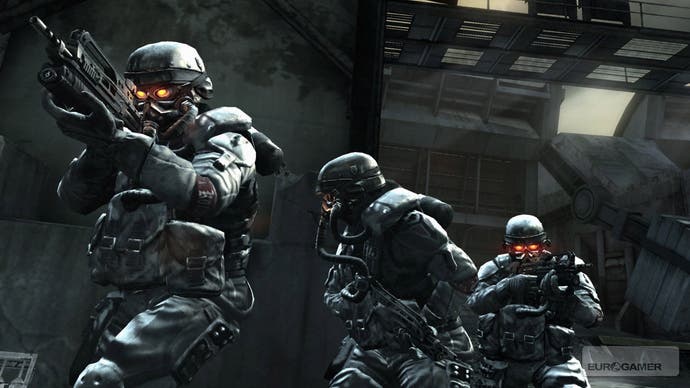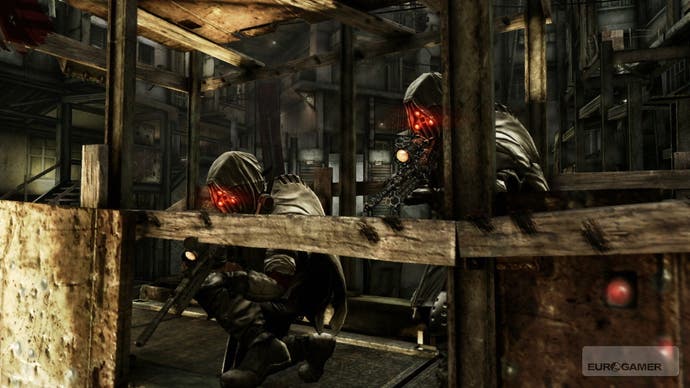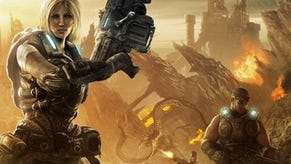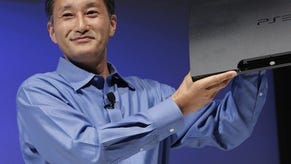Killzone 2
Guerrilla warfare.
Guerrilla's proud of the world it's created, but it isn't about to let visual excess lead the game over a cliff. In amongst presentations on lighting, dynamic music and weapon design, the word we hear most often is "balance". Take visuals: too much detail and your eyes don't know where to look. The outcome? You're run over by a tank while you're staring at the wallpaper. Killzone 2's environments are full of intricacies, but the developer is careful to use lighting and blur to guide you towards the important details. It's the same with physics: "We still want to have a game that's progressable," says development director Arjan Brussee. "Sometimes you can do things which are too much: blow up a tank in the middle of the road and it's hard to get around it. As with everything else, it's finding that balance between the destructible and the non-destructible."
Looks and physics will only get you so far, however, and when it comes to the core experience, the developers have a simple goal. They want to make Killzone 2 one of the most intense console shooters around, and that means zeroing on the simple business of killing people. The team has identified weak hit-response as one of the key elements that damaged the first game, and they've spent a lot of time working on a blend of physics and animation to improve it. Where previously enemies would scarcely react as you fired endless clips into their stomachs, they now jolt, twist and writhe under the impact of bullets, before slumping to the ground after a more realistically brief onslaught. It may seem like a strange detail to fixate on, but it's astonishing how much drama the right reactions can bring to the game's shootouts. When you fire guns in Killzone 2, it's immediately obvious that you're making things happen, and the result is a more involving experience, even on a short playthrough.
AI was an arguably a bigger problem with the original game, and it's another aspect the team have taken pains to address. "With AI the frustrating thing is if you get 90 per cent right, that last ten per cent with someone who gets stuck on a wall can let you down," says game designer Rob Heald. "Killzone 2's AI is still an evolution of the AI in the original, we haven't started from scratch. But we have taken advantage of the technology. The AI can make more decisions, decide between greater threats and different inputs. They're capable of dealing with a much more dynamic world. You'll see a lot more rolling out of the way of grenades, flanking, avoiding destructible objects. It's a cliché, but you won't see the same encounter play out twice. And there's more variety in the enemies: there's long-range guys, and short-range guys who will move in and flush you out."

Playing through a few sections of the campaign reveals that the Helghast have become fearsome opponents, far removed from the pop-up targets of the first game. They soften you up from afar, move in to flank, and will come looking for you if you start to hang back, and the game's varied levels give you plenty of time to try out different strategies as the fighting switches between open environments and grotty close-up battling. Set-pieces are everywhere, from a tank suddenly barrelling over a wall before disgorging troops into the heart of your squad, to a prolonged scramble through a collapsing military installation, and the opening dropship invasion.
The controls will take some getting used to. An emphasis on realistic recoil means that Killzone 2's weapons can initially feel unwieldy rather than simply weighty, and the slightly slippery aim, which seems too slow in the centre of the screen and too quick at the edges, is going to require acclimatisation for any hardcore COD players. But even though the game allows you generous options for tweaking sensitivities, assigning different button layouts, and effectively recreating any other game's mapping, the more we played, the less we wanted to substitute Guerrilla's control scheme for something more familiar. After an hour or so, Killzone's layout starts to make sense, its weak running and gunning options forcing you to find a space and make use of the iron sights, while the slightly slow turning and lengthy reload animations draw you into a game that plays out at a tenser, more measured pace than COD or Halo.

Throw in a cover system - in single-player only - that doesn't take the player out of the first-person perspective, but instead relies on a surprisingly cinematic lean-and-peak mechanic, and you have a seriously tactical, if traditional shooter starting to find its feet. The overall feeling of what we've played so far is a carefully constructed solidity: Killzone 2's world may not constantly surprise you, but it's remarkably tangible, from the heavy guns, to the thick, alien wind roaring in your face, and the drunken staggers of dying enemies. Despite its conservative aims - rather than introduce new ideas, Guerrilla wants to perfect a few old ones - no other shooter plays quite like Killzone 2, and no other shooter looks quite like it, either. That's a risk in a market as saturated as this, but the one thing Guerrilla has never struggled with is drawing attention to itself. Now at last there are promising indications that it's got the game to go along with the hype.
Killzone 2 is due out exclusively for PlayStation 3 in February.















